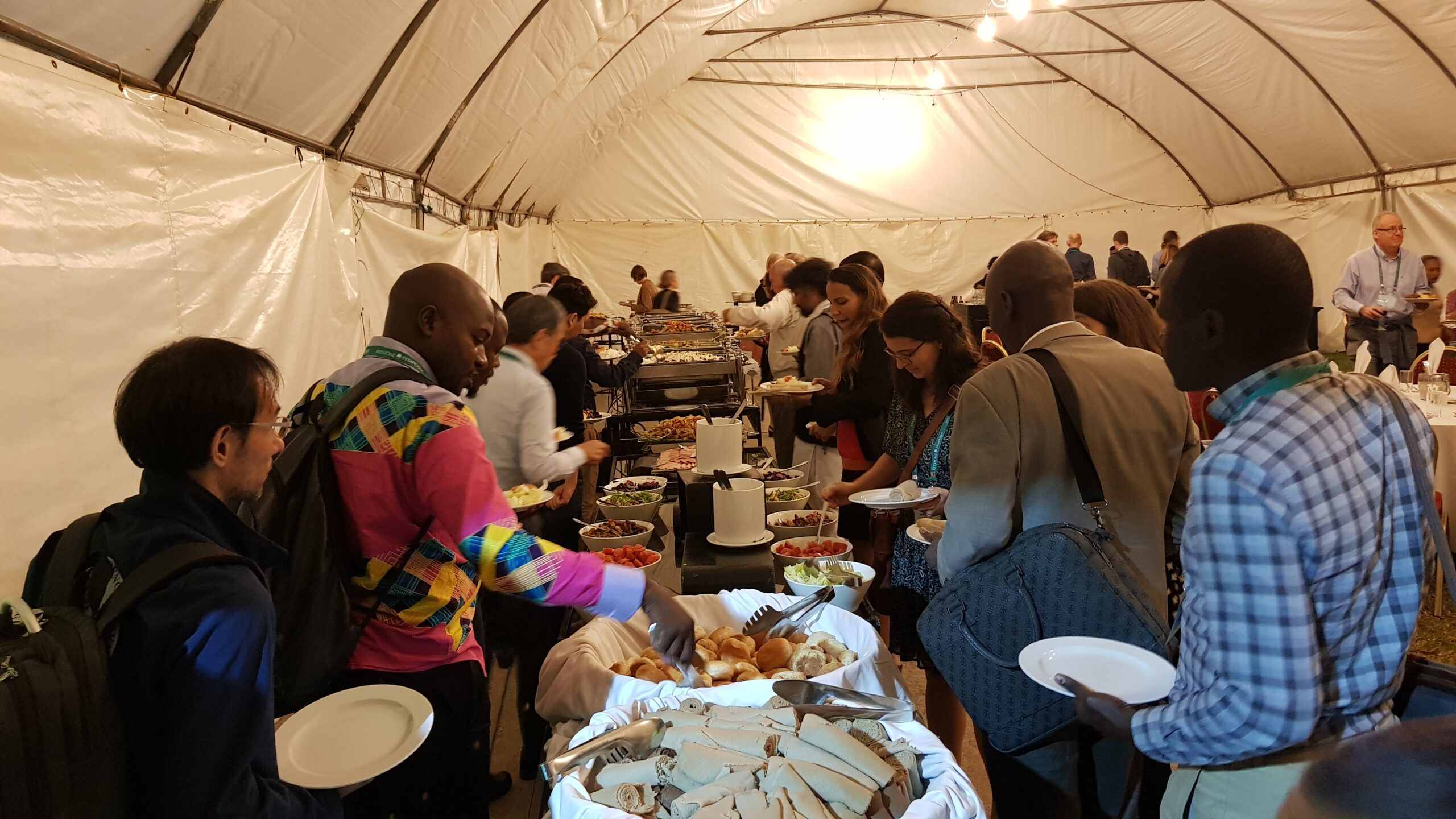Keystone Symposia “The Malaria Endgame” – 2019: Day 3
Friday, 1st November 2019
Published: 01/11/2019
This report is brought to you by the MESA Correspondents Solomon M. Abay, and Maya Fraser. Senior editorial support has been facilitated by Hannah Slater (PATH) and Flaminia Catteruccia.
THEMES: THEMES: Basic Science | Epidemiology | Health Systems
MESA Correspondents bring you cutting-edge coverage from the Keystone Symposia “The Malaria Endgame: Innovation in Therapeutics, Vector Control and Public Health Tools”
Day 3: Friday, 1st November 2019
Leveraging Data Science to Defeat Malaria I
Lucy C. Okell (Imperial College London, UK) started off the “Leveraging Data Science to Defeat Malaria” session with an explanation of various modelling projects looking at the impact of antimalarial treatment and artemisinin resistance. The first project looked at the relationship between delayed treatment and the development of severe malaria. She also discussed a project led by Joe Challenger suggesting that the effectiveness of ACTs is fairly robust to poor adherence. Finally, she evaluated the potential for the development of DHA-P resistance if it is used for intermittent preventative treatment in pregnancy.
Emilie Pothin (Swiss Tropical and Public Health Institute, Switzerland) shared her experience on Data-Driven Operational Stratification for National Malaria Control Programs. She outlined the need for operational stratification to ensure efficiency of the malaria program. She described that data-driven operational stratification allows one to consider the heterogeneity associated with the decline in malaria endemicity and make evidence-based decisions. The iterative modelling process has data inputs and outputs that are continuously improved and discussed with policymakers. The outcome is a decision tool that can be used to allocate interventions in each stratum. The application of this model in Tanzania revealed the need to revise the national malaria strategic plan if the required impact on malaria burden in the country was to be met.
Samson Kiware (Ifakara Health Institute, Tanzania) presented about a Mosquito Database Management System (MDbMS) applicable to diverse entomological studies. He pointed out the challenges encountered in most entomological studies related to variabilities in experimental design, which influenced the development of a data management system. The team developed the forms required, starting from field collection to sample observation and storage. They have made this available in an app for customization. He expressed his hope that countries will use this system if they lack well-designed generic paper-and/or electronic-based data collection tools.
Hannah Slater (PATH), the beloved senior editor of these MESA Correspondents reports, discussed modelling the impact of different stratification strategies in Senegal. This was a great practical example of the work discussed by Emily Pothin. She used the Imperial College malaria model to compare the effects of various combinations of Mass Drug Administration (MDA), Indoor Residual Spraying (IRS), Seasonal Malaria Chemoprevention (SMC), and high levels of treatment and found that all suggested packages besides MDA had comparable efficacies and cost-effectiveness. Finally, she called attention to the fact that the majority of cases in the low-transmission areas of Northern Senegal are occurring in only 20% of the facilities, an argument for understanding and targeting transmission at a very granular level.
Duncan Kobia Athinya (Vestergaard Frandsen Limited, Kenya) shared the Insecticide Resistance (IR) Mapper, a platform of insecticide resistance data that are freely available and can easily be filtered to answer different research questions. Data are updated monthly, and the database currently has over 32000 data points. Soon, it will also contain modelled resistance data from the Malaria Atlas Project. Please contact Duncan if you are interested in contributing data to this database.
Maria Tusell (MESA Alliance, Barcelona Institute for Global Health, Spain) presented the MESA Track platform and its goal to landscape research to showcase emerging evidence and guide the decision-making process. She expressed the need for objectively reviewing available data to develop policy recommendations. She shared with the audience the data sources for MESA TRACK, the magnitude of projects available in the database, and the types of information users can generate from the platform. MESA TRACK is an important resource for different stakeholders such as researchers, research institutions, funders, and policymakers. The platform can help stakeholders to recognize the areas of research most in need of a response, enabling the malaria community to respond accordingly.
Michelle Hsiang (The University of Texas-Southwestern Medical Center and University of California San Francisco – UCSF, USA) talked about a randomized controlled trial of reactive focal mass drug administration (rfMDA) and reactive vector control (RAVC) that took place in Namibia. This study compared a controlled group with groups where each of the two interventions were done singly, and then a group where both interventions took place at once. She found that in an analysis adjusting for pre-intervention transmission levels and other confounders, all intervention combinations had a significant impact on clinical incidence compared to the control arm.
Maya Fraser (PATH, USA and one of our MESA correspondents) began the workshop session talking about how she had used routine surveillance data to conduct an impact evaluation of MDA in Southern Zambia. She concluded that while MDA had a significant impact on incidence, it was not enough to be an accelerant to elimination in the conditions under which it had been implemented. She also urged participants to think about how more routine data can be used to determine impact.
Laurent Dembele (University of Sciences, Techniques and Technologies of Bamako, Mali) shared with us approaches for novel antimalarial discovery against Plasmodium relapsing species, P. vivax and P. ovale. He stated that there was no robust model to conduct drug discovery targeting hypnozoites. His team validated P. cynomolgi in vitro model using Macaca fascicularis primary hepatocytes and characterized Liver-Specific Protein 2 (LISP 2) as marker of hypnozoite activation that is not expressed in dormant types. He also showed that LISP 2 negative forms are only susceptible to an anti-relapse drug, tafenoquine. The absence of this marker in dormant hypnozoites may be related to variabilities in activities of KDU691 on primary and secondary hypnozoites. These results provide novel biological insights in the hypnozoite activation and an early marker suitable for the development of drug discovery assays predictive of anti-relapse activity.
Lauren Beth Arendse (University of Cape Town, South Africa) oriented us on pathways in establishing a Plasmodium kinase platform used in target-based malaria drug discovery. Whole cell phenotypic screening conducted by H3D resulted in a kinase inhibitor that has reached Phase II clinical trial. She shared with the audience a target-based drug design using Plasmodium falciparum phosphatidylinositol 4-kinase (P14K) and cGMP-dependent protein kinase (PKG). Using these approaches, they identified many molecules in a chemical class of imidazopyridazones that inhibit different kinases, which affect multiple stages and blood stages of parasites, respectively.
Monica Golumbeanu (Swiss Tropical and Public Health Institute, Switzerland) demonstrated why it is important to take vector species and behavior into account when modelling the potential impact of different interventions. As examples, she showed how three vector species had very different biting behaviour and resting patterns. When coupled with data about human behaviour, the Anopheles model (part of the Swiss TPH malaria model) can give us a more nuanced view. It will soon be released as an R package and will have an interface for easy access.
Steven Gowelo (Wageningen University, Netherlands) presented the outcomes of his project assessing the effects of sublethal doses of Bacillus thuringiensis israelensis (Bti) treatment in larvae on selected mosquito fitness parameters. His team conducted Bti assay and identified sublethal doses that were used in the experiment in fitness parameters of Anopheles coluzzii females. The study revealed a different impact on adult size and longevity across the sublethal doses of LC20, LC50, LC70 applied during larval stages. As the sublethal dose increased to LC70 longevity reduced and size increased. But oviposition was not associated with sublethal dose variation.
Kitty F. Cardwell (Oklahoma State University, USA) discussed the MicrobeFinder® (MiFi) tool, which allows researchers to design “e-probes” that aid in identifying particular stretches of DNA that could be markers of species, resistance, or anything else of interest. She estimates that doing detection for Plasmodium species would take about 5 minutes in the field with next-generation sequencers. They are currently looking for research partners, so let them know if you are interested.
Leveraging Data Science to Defeat Malaria I
Michael White (Institute Pasteur, France) spoke on a topic close to the forefront of many attendees thoughts: what is the impact of introducing tafenoquine (TQ) for radical cure of P.vivax? Specifically, he examined this question in Brazil, which just approved TQ this week. He combined the Brazilian malaria epidemiology with a mathematical model of P. vivax transmission to assess the potential public health impact of TQ treatment. He found that the additional impact of TQ would be dependent on the age distribution of P. vivax infections, the current availability and adherence to primaquine, and transmission intensity.
Melissa Penny (Swiss Tropical and Public Health Institute, Switzerland) described that models to date have been generated for specific stages of product development. She stressed the need to have models generating evidence in the whole development pathway from discovery research to translational research, extending to clinical development and implementation research. To this account, her team developed a new approach to use models and machine learning to inform target product profiles of new tools, and to identify key determinants of intervention impact in low transmission areas and other settings. Overall, she informed the attendants that a model is a useful tool for formalizing assumptions and providing outputs to inform decision making.
Daniel Neafsey (Harvard TH Chan School of Public Health, USA) spoke about techniques for determining relatedness in parasites and its potential applications. Specifically, older descent models used identity by state (IBS), which is often unable to tell recent changes and is not comparable across different parasite populations. Instead, he suggested using identity by descent (IBD), which is now possible due to the development of Markov models such as hmmIBD. These models are informed by known allele frequencies in the parasite, they are transportable across studies, and can be used with any type of genetic marker (SNPs, micro-satellites, etc).
Mphasto Phiri (Malawi-Liverpool-Wellcome Trust Clinical Research Programme, Malawi) discussed results from a randomized controlled trial in Burkina Faso and Mali that tested whether adding azithromycin (AZ) to seasonal malaria chemoprevention (SMC) would result in an additional mortality reduction. Children were given up to four cycles a year of either SMC+AZ or SMC+placebo. Though the researchers did not find an additional effect on mortality or hospitalization, they did find that there was a 15% reduction in respiratory and gastro-intestinal illnesses. He looked at the prophylactic effect of AZ on clinical malaria cases and found that it was quite modest, about 1-2 weeks only.
Donnie Mategula (Malawi-Liverpool-Wellcome Trust, Malawi) presented his findings of geostatistical analysis of Malawi’s changing malaria transmission from 2010 to 2017. He assembled 2237 Plasmodium falciparum parasite prevalence surveys and calculated population-adjusted prevalence and populations at risk by the district to inform malaria control program priority setting. He revealed that overall transmission was reduced in the country by 47.2% from 2010 to 2017 and that it had shifted to the south. The decline in prevalence was not equal across the country and was heterogeneous. He recommended the scale-up of malaria control interventions and identifying factors for heterogeneity.
This report is brought to you by the MESA Correspondents Solomon M Abay (University of Addis Ababa, Ethiopia) and Maya Fraser (PATH). Senior editorial support has been facilitated by Hannah Slater (PATH) and Flaminia Catteruccia (Harvard T.H. Chan School of Public Health). This report is cross-posted on the MESA website, the Keystone Symposia Keypoint Blog and on MalariaWorld.
Published: 01/11/2019
This report is brought to you by the MESA Correspondents Solomon M. Abay, and Maya Fraser. Senior editorial support has been facilitated by Hannah Slater (PATH) and Flaminia Catteruccia.
THEMES: Basic Science | Epidemiology | Health Systems


